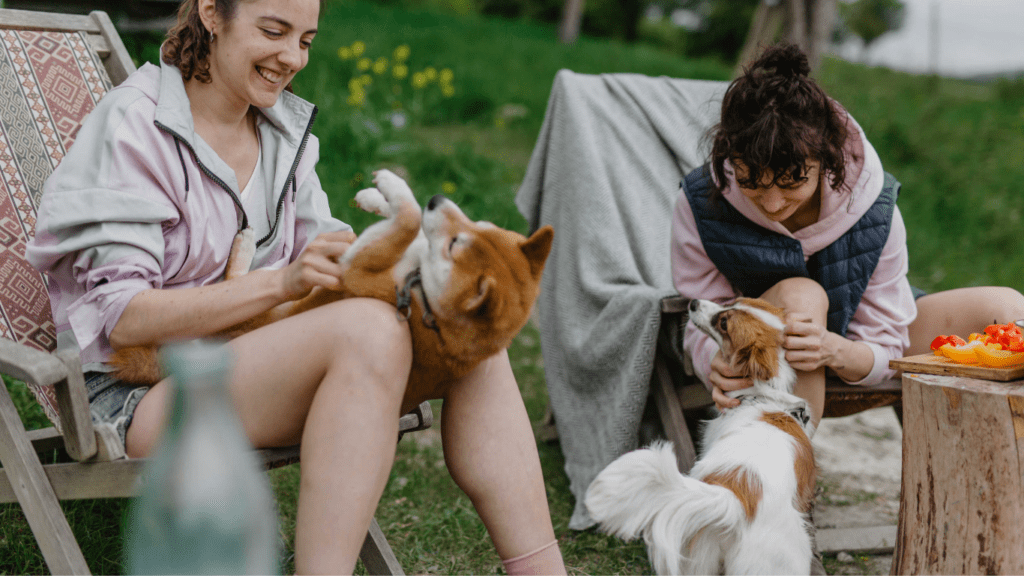Picture this: You’re three hours into your dream van life adventure when your usually calm Golden Retriever starts panting heavily, drooling, and whimpering in the corner. Your cat hasn’t eaten since you left home, and your rescue dog is trembling every time you start the engine. Sound familiar? You’re not alone – pet travel anxiety affects millions of furry companions, and van travel presents unique challenges that traditional car trips simply don’t.
Unlike quick car rides to the vet, van travel means your pet’s world is literally moving for extended periods. The confined space, constant motion, unfamiliar sounds, and changing environments can trigger anxiety responses that leave both pets and owners stressed and exhausted.
But here’s the good news: with the right preparation, modifications, and techniques, you can transform your van into a mobile sanctuary that actually calms your anxious pet instead of stressing them out.
Understanding Van-Specific Anxiety Triggers
Van travel creates a perfect storm of anxiety triggers that don’t exist in regular vehicles:
Prolonged Confinement: While a 20-minute car ride might be manageable, hours or days in a moving space can overwhelm pets who need mental stimulation and physical release.
Engine Vibrations and Noise: Van engines typically run louder and create more vibrations than cars, which can be particularly distressing for noise-sensitive animals.
Spatial Disorientation: The larger van interior means pets can’t easily see outside or orient themselves to their surroundings, creating a sense of being lost in space.
Unfamiliar Territory: Every day brings new sights, sounds, and smells, which can be overwhelming for pets who thrive on routine and familiarity.
Limited Escape Routes: Anxious pets often seek hiding spots or escape routes. In a van, these options are severely limited, intensifying their stress response.
Pre-Travel Preparation: Building Confidence Before You Roll
The key to successful van travel with anxious pets starts weeks before your first trip. Sarah, a client who worked with our van conversion team, learned this the hard way when her rescue dog Max had a panic attack during their maiden voyage to Yellowstone.
Gradual Desensitization Protocol
Start with 15-minute stationary sessions in your parked van. Let your pet explore, sniff, and claim their space without the stress of movement. Gradually increase these sessions to 30 minutes, then an hour, always ending on a positive note with treats and praise.
Next, introduce engine noise. Run the engine while parked, starting with just a few minutes and building up tolerance. This helps pets associate the engine sound with positive experiences rather than stress.
Creating Familiar Anchors
Pack their favorite blanket, toy, or bed – something that smells like home. These familiar scents act as emotional anchors in an otherwise unfamiliar environment. Place these items in designated “safe zones” within your van.
Practice Short Drives
Once your pet is comfortable with the stationary van, take 10-minute drives around familiar neighborhoods. Gradually extend these practice runs, always returning home so your pet learns the van eventually leads back to safety.
Van Design Solutions for Anxious Pets
Your van’s layout can either amplify or alleviate pet anxiety. Professional van outfitters who specialize in pet-friendly conversions understand that thoughtful design makes all the difference.
Strategic Window Placement
Install windows at your pet’s eye level so they can see outside and maintain visual connection with the world. This reduces the trapped feeling that triggers claustrophobia. Consider adding window perches for cats or small dogs who find comfort in observing their surroundings.
Designated Safe Zones
Create multiple retreat areas throughout your van. These might include:
- A cozy nook under the bed with soft sides
- A secured area near the driver’s seat for pets who find comfort in being close to their humans
- An elevated platform for cats who prefer to observe from above
Ventilation and Temperature Control
Anxious pets overheat quickly, and poor air circulation can intensify their distress. Install multiple roof vents, side vents, and fans to ensure constant airflow. Consider a diesel heater for cold climates and adequate cooling solutions for hot weather.
When Mark contacted our van service about his anxiety-prone Border Collie, we installed a specialized ventilation system that maintains optimal temperature and air quality regardless of outside conditions. The result? His dog now travels calmly for 8-hour stretches.
During-Travel Management Strategies
Even with perfect preparation and design, you’ll need active management techniques during travel.
The Power of Routine
Maintain feeding, walking, and play schedules as closely as possible. Anxious pets find tremendous comfort in predictable routines, even when everything else is changing.
Strategic Stop Planning
Plan stops every 2-3 hours, not just for bathroom breaks but for mental reset time. Research dog parks, pet-friendly hiking trails, or even large parking lots where your pet can safely explore and decompress.
Calming Techniques During Transit
- Use calming pheromone diffusers designed for travel
- Play soft music or white noise to mask road sounds
- Maintain calm energy yourself – pets pick up on your stress
- Consider natural calming supplements (consult your vet first)
Emergency Protocols
Keep a “panic kit” easily accessible:
- Favorite treats for distraction
- Calming supplements
- Emergency contact for your vet
- Backup comfort items
Advanced Solutions for Severe Cases
Some pets require more intensive interventions. Luna, a rescue cat with severe travel anxiety, couldn’t handle any van movement despite months of preparation. Her owners worked with both a veterinary behaviorist and a professional van conversion specialist to create a custom solution.
Professional Modifications
- Sound-dampening materials throughout the van
- Vibration-reducing floor systems
- Custom-built hiding spaces with multiple entry/exit points
- Specialized securing systems that allow movement while maintaining safety
Veterinary Support
Work with your vet to develop a comprehensive anxiety management plan. This might include:
- Anti-anxiety medications for severe cases
- Behavioral training referrals
- Specialized diets that support calm behavior
- Regular check-ins to monitor progress
Technology and Tools That Help
Modern van conversions can incorporate technology specifically designed for anxious pets:
Monitoring Systems: Install cameras that let you observe your pet’s behavior and stress levels while driving. Some systems even include two-way audio so you can provide verbal reassurance.
Automatic Feeders and Water Systems: Maintaining normal eating and drinking patterns helps reduce anxiety and provides routine comfort.
Climate Control Apps: Smart systems that monitor and adjust temperature, humidity, and air quality automatically, ensuring your pet’s environment remains optimal.
Building Long-Term Travel Confidence
Remember that overcoming pet travel anxiety is a marathon, not a sprint. Each successful trip builds confidence for the next one. Keep a travel journal noting what works and what doesn’t, and don’t hesitate to adjust your approach based on your pet’s responses.
The goal isn’t just to manage anxiety – it’s to help your pet genuinely enjoy the van life experience. When done right, many pets become more confident and adaptable through van travel, discovering new environments and experiences in the safety of their mobile home.
For Those Without a Van
Don’t own a van but want to experience stress-free pet travel? You’re not stuck with cramped car rides or expensive pet-friendly hotels. Many van rental services now specialize in pet-friendly vehicles that come pre-equipped with features designed to reduce anxiety, including proper ventilation, comfortable sleeping areas, and safety modifications.
These services understand that not every pet owner is ready to invest in a complete van conversion, but they still want to provide their anxious pets with comfortable travel experiences. Professional van services can outfit rental vehicles with temporary modifications or provide fully equipped, pet-friendly vans for weekend getaways or extended trips.
Some services even offer consultation packages where experienced van conversion specialists assess your pet’s specific anxiety triggers and recommend the best rental options or temporary modifications for your needs. This allows you to test different solutions and see what works best for your pet before making any long-term commitments.
Moving Forward
Van travel with anxious pets is absolutely achievable with the right preparation, modifications, and mindset. Whether you’re planning weekend getaways or full-time van life, your pet can learn to love the journey as much as the destination. Professional van outfitting services that specialize in pet-friendly conversions can make a significant difference, especially for pets with severe anxiety, and the investment in proper design and modifications often pays for itself in reduced stress, fewer emergency vet visits, and countless happy travel memories. Your anxious pet doesn’t have to miss out on the van life adventure – they just need the right support system to help them thrive on the road.


 Lead Pet Behavior Specialist
Brian Camacho is an expert in pet behavior and training at Pet Paw Shack. With a deep understanding of animal psychology, he specializes in helping pets and their owners build strong, healthy relationships through positive reinforcement techniques. Brian’s innovative approach to training focuses on making behavior modification a fun and rewarding experience for both pets and their families.
Lead Pet Behavior Specialist
Brian Camacho is an expert in pet behavior and training at Pet Paw Shack. With a deep understanding of animal psychology, he specializes in helping pets and their owners build strong, healthy relationships through positive reinforcement techniques. Brian’s innovative approach to training focuses on making behavior modification a fun and rewarding experience for both pets and their families.
